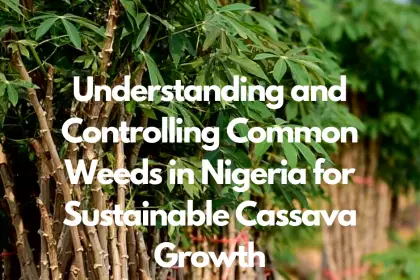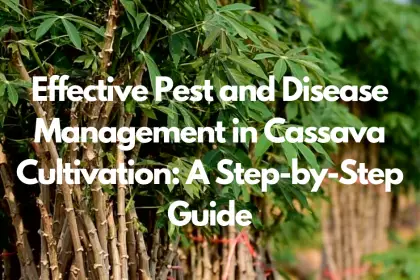Cassava stands as a cornerstone of agriculture in Côte d’Ivoire, blanketing approximately 80% of the national territory with its cultivation. Recognized for its dual role, cassava serves not only as a vital subsistence crop but also as an important cash crop for producers. The intricate dynamics of the cassava market, from the planting of cassava to its harvest and sale, underscore the necessity for adept knowledge and practices to secure good yield and profitability. Additionally, climate change introduces another layer of complexity, potentially altering planting schedules and affecting yields, thus making the mastery of these agricultural practices even more crucial.
In navigating the path towards optimal production on a cassava farm, the selection of appropriate cassava varieties and effective pest control emerges as key components. Such strategies are essential to overcome challenges and embrace opportunities within the cassava market. Furthermore, the diversity in the use of cassava, spanning from human and animal food to industrial applications, illustrates its significant economic potential. This guide aims to delve into Good Agricultural Practices (GAPs) tailored specifically for cassava farming, intending to bolster yield, enhance market value during the peak seasons, and ultimately contribute to the empowerment of communities involved in cassava cultivation.
Importance of Cassava as a Staple Crop
Cassava, a significant staple crop, plays a crucial role in the nutrition and economy of Nigerian households, with its importance echoing across various dimensions:
- Nutritional Value and Versatility:
-
- Rich in carbohydrates, dietary fiber, vitamin C, and some B vitamins, cassava stands out as a nutritious food option.
- Its root can be processed into a variety of forms such as flour, chips, and pellets, showcasing its versatility in usage.
- Economic and Food Security Contributions:
-
- As the world’s leading producer, Nigeria generated about 54.8 million MT in 2014, underscoring cassava’s role in the global market and local economies.
- Cassava’s drought tolerance and ability to grow on marginal lands make it a key crop for ensuring food security, especially in areas prone to crop failures.
- Societal Impact:
-
- Serving as a primary food source for over 800 million people globally, cassava is pivotal in sustaining families during food shortages.
- In Nigeria, cassava production, largely managed by small-scale farmers and significantly contributed to by women, emphasizes its role in supporting households and empowering communities.
Understanding Good Agricultural Practices (GAPs)
Good Agricultural Practices (GAPs) in cassava farming encompass a holistic approach aimed at enhancing agricultural productivity while mitigating negative environmental impacts. These practices are pivotal in ensuring sustainable cassava production and include:
- Soil Management:
-
- Regular soil testing to determine nutrient requirements.
- Adjusting fertilization based on soil test results.
- Implementing crop rotation with leguminous crops to improve soil structure and fertility.
- Pest and Disease Control:
-
- Integrated Pest Management (IPM) strategies including:
-
- Monitoring pest populations.
- Using biological controls.
- Applying pesticides only when necessary.
- Water and Weed Management:
-
- Efficient water use techniques such as drip irrigation and mulching.
- Weed management through mechanical, cultural, or chemical methods.
Furthermore, the adoption of improved cassava technologies, such as the use of disease-resistant varieties and appropriate fertilization following the ‘4Rs’ principle (Right type, Right rate, Right timing, and Right method), has shown positive impacts on productivity. Studies, like the one conducted in Ogun State, Nigeria, highlight the significant relationship between the effectiveness of agricultural programs’ technical information and the adoption of these improved technologies. This underscores the importance of extension services, training, and access to information for smallholder farmers in enhancing cassava farm productivity and sustainability.
Challenges in Traditional Cassava Farming
Traditional cassava farming faces a multitude of challenges that can significantly impact productivity and sustainability. These challenges span across technical difficulties, socio-economic issues, and environmental concerns:
Technical Challenges:
- Disease and Pest Management: Cassava is susceptible to a variety of diseases and pests, including cassava mosaic disease (CMD), cassava bacterial blight (CBB), and pests like whiteflies and mealybugs. These can lead to substantial yield losses.
- Agronomic Issues: Problems such as low nitrogen use efficiency, poor cooking qualities, and high cyanogenic levels in cassava require careful management and breeding efforts.
- Post-Harvest Losses: Issues like post-harvest physiological degradation and long maturation duration contribute to inefficiencies, with up to 52% of cassava output wasted.
Socio-Economic and Environmental Concerns:
- Market and Infrastructure Limitations: Limited market access, inefficient extension delivery systems, and inadequate access to improved processing technology hinder the cassava subsector’s growth.
- Environmental Impact: Unsustainable farming practices can lead to habitat destruction and soil degradation, exacerbating the environmental footprint of cassava cultivation.
- Poverty and Labor: Cassava farming is closely associated with poverty, and the heavy involvement of women and children in cassava production underscores the need for interventions that can enhance productivity and livelihoods.
Addressing these challenges requires a multi-faceted approach, including advancements in breeding and genetic improvement, development of sustainable crop management practices, and strengthening of market and infrastructure support systems.
Adoption Levels and Impact of GAPs in Cassava Farming
Strategies to elevate the cassava farm as a major contributor to food security and income generation are being developed, focusing on the industrialization of cassava production for both food and industrial purposes. This includes fostering a sustainable seed system and enhancing extension services. Key areas of focus include:
- Weed Control: Utilizing both chemical and alternative methods to manage weed growth in cassava fields.
- Processing Improvements: Enhancing cassava processing efficiency to reduce labor for children and increase financial resources for women, thereby improving education, welfare, and health for women and children.
In regions like Brazil, India, and Thailand, smallholder cassava farmers have achieved remarkable yields of 25-40 tonnes per hectare through intensive farming practices. This success is attributed to:
- Monocropping on Larger Fields: Future practices are likely to involve monocropping cassava on larger fields.
- Adoption of High-Yielding Genotypes: The use of higher yielding cassava varieties.
- Increased Use of Irrigation and Agrochemicals: Implementing modern farming techniques including irrigation and agrochemicals.
The adoption of Recommended Cassava Production Practices (RCPPs) has significantly increased both the yield and income of cassava farmers, with a notable 67% increase in average yield and a 54% increase in average income post-adoption. Factors influencing the adoption of improved cassava varieties include access to improved cassava cuttings, use of radio for information dissemination, farming experience, and farming as a primary occupation. These practices not only enhance the productivity and sustainability of cassava farming but also significantly improve the welfare of farming households by increasing their annual income and consumption expenditure.
Case Studies: Success Stories and Lessons Learned
Innovative Practices and Policy Insights from Cassava Farming:
- Soil and Crop Management Techniques:
-
- Utilizing no-tillage methods in cassava cultivation has been shown to enhance root functionality and maintain long-term soil aggregate stability, highlighting the importance of soil conservation in sustainable agriculture.
- The practice of maintaining continuous ground cover is crucial for protecting the soil surface, reducing runoff and erosion, and inhibiting weed growth, thereby contributing to the overall health of the cassava farm ecosystem.
- Intercropping cassava with early-maturing crops like maize, upland rice, and grain legumes can significantly increase the total net income per unit area and mitigate the risk of total crop failure, demonstrating a strategic approach to diversifying farm income sources.
- Policy and Market Dynamics:
-
- A detailed study in Ikorodu, Lagos State, Nigeria, shed light on the challenges posed by inconsistent government policies on cassava farming, including volatility in the business environment and insufficient government support in terms of financial aid, agricultural extension services, and infrastructure development.
- Farmers emphasized the need for high-yield cassava stems for increased productivity and income, alongside a call for the commercialization of cassava to enhance livelihoods.
- The study advocates for a reformation of cassava policy to include consistent support and involvement from the government, which could lead to positive social changes by improving the livelihoods of cassava farmers and guiding policymakers to address policy instability in the cassava industry.
These insights underline the significance of adopting innovative agricultural practices and the need for stable, supportive policies to ensure the sustainability and growth of the cassava industry, especially in the face of global demand for cassava products.
Conclusion and Future Outlook
Throughout this discourse on the cultivation and significance of cassava, highlighted were the pivotal Good Agricultural Practices (GAPs), the incredible economic and nutritional value that cassava holds, and the substantial socio-economic impacts it brings to communities, particularly in regions like Côte d’Ivoire and Nigeria. Emphasizing the crucial role of cassava as both a subsistence and cash crop, this guide navigated through the challenges besetting cassava farming—from pest management and environmental sustainability to socio-economic hurdles—while presenting practical solutions and the transformative potential of adopting improved agricultural practices and technologies. The insights drawn from case studies and success stories further substantiate how concerted efforts in innovation, policy reform, and adoption of GAPs can empower communities, enhance food security, and boost economic growth in the cassava industry.
Addressing the challenges head-on and leveraging the opportunities, the article underscores the importance of sustainable farming practices, technological advancements, and supportive policies as catalysts for change. The implications are clear: adopting such measures and practices not only improves the livelihood of cassava farmers but also has a broader impact on the agricultural sector at large, promising better yields, enhanced incomes, and a shift towards more sustainable agricultural ecosystems. As the world continues to recognize the value of cassava, further research, policy formulation, and community support are essential in harnessing its full potential, thereby paving the way for a resilient and prosperous agricultural future.
FAQs
What are the best practices for managing a cassava farm?
To effectively manage a cassava farm, it is crucial to avoid or improve certain types of soils such as stony, clay, shallow, hard, or waterlogged soils. On sandy soils, it’s important to implement minimum tillage techniques to preserve the soil, its organic content, and moisture, while also minimizing erosion. For soils that do not drain well, creating ridges or mounds can help mitigate waterlogging issues.
Can you outline the main stages of cassava farming?
Cassava farming involves several key stages, which include:
- Selecting an appropriate site for the farmland.
- Preparing the soil for planting.
- Choosing the right variety of cassava to plant.
- Acquiring the necessary equipment.
- Setting up an irrigation system if needed.
- Considering the climatic conditions for growing cassava.
- Planting the cassava stems.
- Implementing consistent weed control measures.
What challenges do cassava farmers often encounter?
Cassava farmers face a variety of challenges such as the crop’s long maturation period, variability in dry matter and starch content, high levels of cyanogenic compounds, suboptimal cooking qualities, and susceptibility to diseases like cassava bacterial blight and root rot, especially in forested regions.
How can cassava farming be made more profitable?
To increase profitability in cassava farming, it is advisable to intercrop cassava with other crops. This not only enhances agricultural income but also improves soil health. Legume species, such as cowpea, beans, and groundnut, are especially beneficial because they enrich the soil with nutrients. Cassava can also be profitably grown alongside maize.



